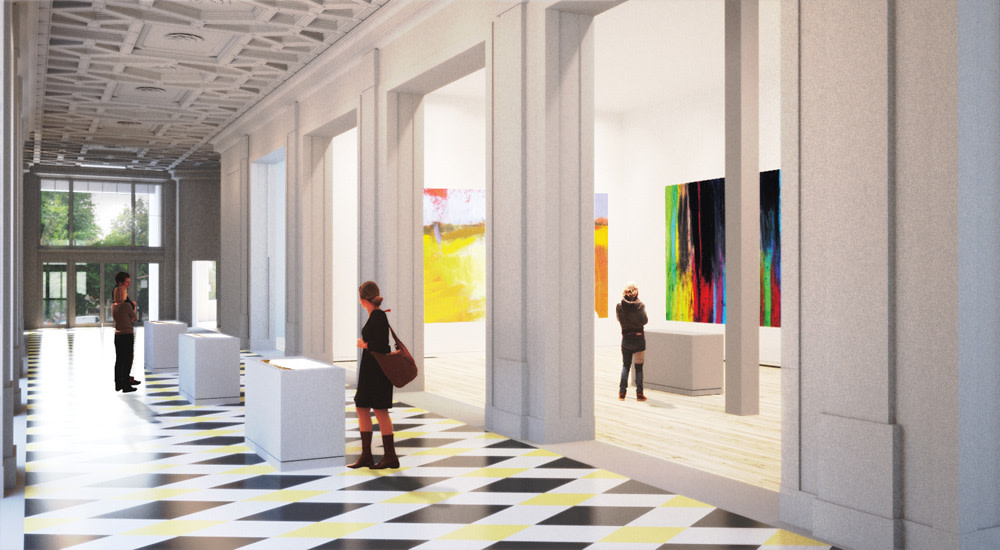Painting a Broader Canvas

An architect’s rendering of PNCA’s future Schnitzer Center for Art and Design
Image: Courtesy PNCA
IMAGINE the corner of NW Broadway and Hoyt Street, two years from now: hundreds of students and professors swarm through the Pacific Northwest College of Art’s Arlene and Harold Schnitzer Center for Art and Design. The former post office gleams after a $15 million renovation guided by acclaimed architect Brad Cloepfil. With sweeping marble floors and natural light pouring in, the school’s flagship building becomes the elbow in the arm connecting Old Town and the Pearl District.
The project, now under construction, will be the most visible symbol of PNCA’s decade-long ascent. The school’s student body has doubled since 2004, to 600 students. Its financial fortunes are even rosier—since 2000, PNCA’s operating budget has more than doubled, and its endowment has exploded from just $1.6 million to more than $13 million. In 2009, PNCA formed a partnership with the financially troubled Museum of Contemporary Craft, and this spring it announced plans for an architecturally adventurous new student housing project on the site of the former Powell’s Technical Books.
And PNCA is just one beneficiary of a trend both national and local: art school enrollment is soaring. In Portland, back-to-school time finds our local arts schools in a bullish mood. Between them, our five highest-profile arts schools have added over a thousand students and about 200 full-time faculty and staff positions in the last decade. Greek debt crisis? Higher-ed budget cuts? Not that art should be all about escapism, but our local schools do seem blissfully removed from such strife.
Why? People in the field note that population trends and the perma-recession have boosted higher-ed enrollment overall. Meanwhile, the evolution of graphic design, video production, and other quasi-commercial disciplines means “art school” is no longer a synonym for “unemployable.”
No single Portland art school can compete for size and resources with top-rung universities like UCLA or Columbia. Nor do any boast the long-established boutique appeal of New York’s School of Visual Arts or Providence’s Rhode Island School of Design. Put them all together, however, and you’ve got something.
The Oregon College of Art & Craft has increased its enrollment by 50 percent in the past decade—it now has about 150 students—and recently opened two new buildings on campus, part of an aggressive expansion plan. Portland State, which faces the same painful cuts that have clipped most of Oregon’s public higher-ed system in recent years, has actually added arts faculty and students, along with new master’s and bachelor’s programs. The University of Oregon’s Portland-based program brings students of urban architecture, digital media, and product design to Old Town. The for-profit Art Institute’s local outpost has also burgeoned, adding a hundred instructors.
This isn’t an isolated phenomenon. For example, AICAD, an alliance of 43 art and design schools across North America, reports a 26 percent increase in members’ enrollment over the past 10 years. Portland’s schools are expanding much more quickly than that—a reflection, in part, of the city’s burnished national reputation. OCAC and PNCA, which once largely relied on students from Oregon, now draw much of their enrollments from elsewhere. (PNCA will embark on its first recruiting effort in South Korea this October.)
True to Portland form, our schools sell innovation, collaboration, and atmosphere. When OCAC and PNCA teamed up three years ago to create a master’s program in Applied Craft and Design, they set their joint project up in an inner-Northeast warehouse, well away from both campuses. Portland State’s Art and Social Practice MFA concentration, a mix of social experiment and the creative arts, and one of only five programs of its kind in the country, is based in a downtown storefront.
Administrators and professors are leaving posts in other major arts centers to join the student influx, and national observers have taken note. “When respected professionals move into new positions, as they are in Portland, people pay attention,” says Samuel Hoi, the president of Otis College of Art and Design in LA. Anne Boerner left Washington, DC’s Corcoran College of Art and Design last year to head OCAC’s enrollment department. And Kavin Buck recently joined PNCA as Vice President of Enrollment Services, leaving his own 5,000-square-foot gallery in Inglewood and a long-term career at the UCLA School of Arts and Architecture. “I felt no threat to my career moving to Portland,” Buck says. “If anything, I’ve become more interesting again.”
At this point, the notion of a “creative class” that will somehow transform our economy looks a little shopworn. But Portland’s many design-oriented industries always need talent. In that, the current art-school boom could pay off well beyond our galleries and performance venues.
“New York and LA have always been anchored by strong secondary arts education institutions,” says Tomi Douglas Anderson, a culture policy advisor to Mayor Sam Adams. “Art schools produce students with rigorous skills and fresh perspectives. They invest in ideas and ask ‘What’s next?’”



